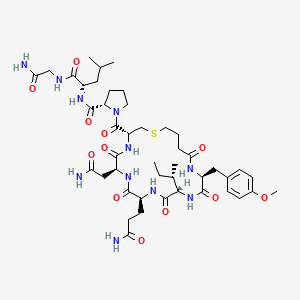



API Suppliers

US DMFs Filed
0

CEP/COS Certifications
0

JDMFs Filed
0
Other Certificates
Other Suppliers
0
0

USA (Orange Book)
0

Europe

Canada

Australia
0

South Africa
Uploaded Dossiers
U.S. Medicaid
0
Annual Reports
0
0


1. 1-deamino-1-monocarba-2-(tyr(ome))-oxytocin
2. Dcomot
3. Depotocin
4. Oxytocin, 1-desamino-1-monocarba-(tyr(ome))(2)-
5. Oxytocin, 1-desamino-1-monocarba-(tyrosine(o-methyl))(2)-
1. 37025-55-1
2. Pabal
3. Carbetocino
4. Carbetocinum
5. Chebi:59204
6. Lv-101
7. Carbetocinum [inn-latin]
8. Carbetocino [inn-spanish]
9. Deamino-2-o-methyltyrosine-1-carbaoxytocin
10. 1-butyric Acid-2-(3-(p-methoxyphenyl)-l-alanine)oxytocin
11. 88twf8015y
12. 1-butanoic Acid-2-(o-methyl-l-tyrosine)-1-carbaoxytocin
13. Fe 992097
14. Fe-992097
15. 7-pentaoxo-1-thia-4,7,10,13,16-pentazacycloicosane-3-carbonyl]pyrrolidine-2-carboxamide
16. C45h69n11o12s
17. (2s)-n-[(2s)-1-[(2-amino-2-oxoethyl)amino]-4-methyl-1-oxopentan-2-yl]-1-[(3r,6s,9s,12s,15s)-6-(2-amino-2-oxoethyl)-9-(3-amino-3-oxopropyl)-12-[(2s)-butan-2-yl]-15-[(4-methoxyphenyl)methyl]-5,8,11,14,1
18. Carbetocin [mi]
19. Carbetocin [inn]
20. Carbetocin [usan]
21. Carbetocin [mart.]
22. Carbetocin [who-dd]
23. Schembl39224
24. Carbetocin [usan:inn:ban]
25. Unii-88twf8015y
26. Chembl3301668
27. Gtpl11169
28. Dtxsid90897527
29. 1-carbaoxytocin, 1-butanoic Acid-2-(o-methyl-l-tyrosine)-
30. (2s)-n-[(2s)-1-[(2-amino-2-oxoethyl)amino]-4-methyl-1-oxopentan-2-yl]-1-[(3r,6s,9s,12s,15s)-6-(2-amino-2-oxoethyl)-9-(3-amino-3-oxopropyl)-12-[(2s)-butan-2-yl]-15-[(4-methoxyphenyl)methyl]-5,8,11,14,17-pentaoxo-1-thia-4,7,10,13,16-pentazacycloicosane-3-carbonyl]pyrrolidine-2-carboxamide
31. Who 5014
32. Einecs 253-312-6
33. Bdbm50044677
34. Mfcd01076600
35. Akos015994647
36. Zinc150338703
37. Db01282
38. Hs-2007
39. Ncgc00485451-02
40. Hy-17573
41. 025c551
42. A823503
43. Carbetocin 100 Microg/ml In Acetonitrile:methanol
44. Q5037853
45. 1-buttersaeure-2-(3-(4-methoxyphenyl)-l-alanin)oxytocin
46. 1-carboxytocin, 1-butanoic Acid-2-(o-methyl-l-tyrosine)-
47. Ethyl?2-chloro-4-(trifluoromethyl)pyrimidine-5-carboxylate
48. (2s)-2-{[(2s)-1-{[(3r,6s,9s,12s,15s)-12-[(2s)-butan-2-yl]-9-(2-carbamoylethyl)-6-(carbamoylmethyl)-15-[(4-methoxyphenyl)methyl]-5,8,11,14,17-pentaoxo-1-thia-4,7,10,13,16-pentaazacycloicosan-3-yl]carbonyl}pyrrolidin-2-yl]formamido}-n-(carbamoylmethyl)-4-methylpentanamide
49. 1-[6-(2-amino-2-oxo-ethyl)-9-(3-amino-3-oxo-propyl)-15-[(4-methoxyphenyl)methyl]-5,8,11,14,17-pentaoxo-12-sec-butyl-1-thia-4,7,10,13,16-pentazacycloicosane-3-carbonyl]-n-[1-[(2-amino-2-oxo-ethyl)carbamoyl]-3-methyl-butyl]pyrrolidine-2-carboxamide; 2,2,2-t;carbetocin
50. 1-{[(3r,6s,9s,12s,15s)-6-(2-amino-2-oxoethyl)-9-(3-amino-3-oxopropyl)-12-[(2s)-butan-2-yl]-15-(4-methoxybenzyl)-5,8,11,14,17-pentaoxo-1-thia-4,7,10,13,16-pentaazacycloicosan-3-yl]carbonyl}-l-prolyl-l-leucylglycinamide
51. Glycinamide, N-(4-mercapto-1-oxobutyl)-o-methyl-l-tyrosyl-l-isoleucyl-l-glutaminyl-l-asparaginyl-l-cysteinyl-l-prolyl-l-leucyl-, Cyclic (1->5)-thioether
52. O-methyl-n-(4-sulfanylbutanoyl)-l-tyrosyl-l-isoleucyl-l-glutaminyl-l-asparaginyl-l-cysteinyl-l-prolyl-l-leucyl-glycinamide Cyclic (1->5)-thioether
| Molecular Weight | 988.2 g/mol |
|---|---|
| Molecular Formula | C45H69N11O12S |
| XLogP3 | -1.1 |
| Hydrogen Bond Donor Count | 10 |
| Hydrogen Bond Acceptor Count | 13 |
| Rotatable Bond Count | 18 |
| Exact Mass | 987.48478785 g/mol |
| Monoisotopic Mass | 987.48478785 g/mol |
| Topological Polar Surface Area | 388 Ų |
| Heavy Atom Count | 69 |
| Formal Charge | 0 |
| Complexity | 1850 |
| Isotope Atom Count | 0 |
| Defined Atom Stereocenter Count | 8 |
| Undefined Atom Stereocenter Count | 0 |
| Defined Bond Stereocenter Count | 0 |
| Undefined Bond Stereocenter Count | 0 |
| Covalently Bonded Unit Count | 1 |
Used to control postpartum hemorrhage and bleeding after giving birth.
Carbetocin is a drug used to control postpartum hemorrhage, bleeding after giving birth. It is sold under the trade name Duratocin. It is an analogue of oxytocin, and its action is similar to that of oxytocin; it causes contraction of the uterus.
Delayed-Action Preparations
Dosage forms of a drug that act over a period of time by controlled-release processes or technology. (See all compounds classified as Delayed-Action Preparations.)
Oxytocics
Drugs that stimulate contraction of the myometrium. They are used to induce LABOR, OBSTETRIC at term, to prevent or control postpartum or postabortion hemorrhage, and to assess fetal status in high risk pregnancies. They may also be used alone or with other drugs to induce abortions (ABORTIFACIENTS). Oxytocics used clinically include the neurohypophyseal hormone OXYTOCIN and certain prostaglandins and ergot alkaloids. (From AMA Drug Evaluations, 1994, p1157) (See all compounds classified as Oxytocics.)
H - Systemic hormonal preparations, excl. sex hormones and insulins
H01 - Pituitary and hypothalamic hormones and analogues
H01B - Posterior pituitary lobe hormones
H01BB - Oxytocin and analogues
H01BB03 - Carbetocin
Absorption
Bioavailability is 80% following intramuscular injection.
40 minutes
Carbetocin binds to oxytocin receptors present on the smooth musculature of the uterus, resulting in rhythmic contractions of the uterus, increased frequency of existing contractions, and increased uterine tone. The oxytocin receptor content of the uterus is very low in the non-pregnant state, and increases during pregnancy, reaching a peak at the time of delivery.


